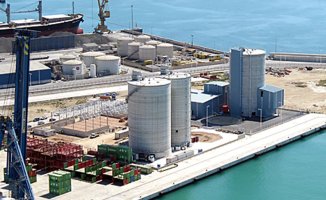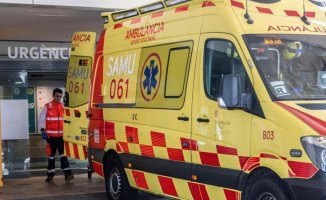There is no Barcelona tourist guide that does not recommend a visit to the Boqueria market. It could be said that anyone who has been to the city has walked through this true paradise for the senses where we can find all kinds of food and which opened its doors in 1836. A festival of smells, colours, shapes and flavors that are hard to forget. More than 200 merchants offer all kinds of products every day in a space from another time located at the foot of the Rambla. An emblem that has now also become part of the history of the Catalan capital for being a pioneering space in the use of new technologies. Specifically, in exploring the possibilities offered by the deployment of the 5G network.
Although it has been common for many mobiles to connect via 5G for years, the truth is that the deployment of this technology and the many possibilities it provides is still in the experimentation phase.
The true purpose of 5G is not only the quality of a call we make from our mobile or how fast we can surf the internet, but rather the possibility of offering an environment that allows the development of a wide range of disruptive technologies.
Barcelona occupies a privileged position in the race to become one of the first cities in the world with a 5G SA network, deployed in an urban environment thanks to the 5G Catalunya pilot project, promoted by Red.es, a public business entity attached to the Ministry of Economic Affairs and Digital Transformation. This initiative, endowed with a budget of 5.4 million euros that comes in part from the European Regional Development Fund (ERDF), will develop seven use cases in the coming months in addition to the 5G network deployment project. The Boqueria case is the first of these cases developed by one of the consortium partners.
To talk about this experience and the possibilities offered by 5G, La Vanguardia has brought together representatives of the three companies that have successfully developed the test of an immersive online shopping experience, with augmented reality and in real time, of products from one of the stops of the historic market.
Cellnex Telecom is responsible for coordinating the pilot and fully deploying the 5G access network to the seven use cases that make up the 5G Catalunya pilot. Eduardo Fichmann, global director of innovation and strategy of this technology, assures that it is “an opportunity to participate in one of the first initiatives carried out in the world for the deployment of 5G in a city like Barcelona”. Fichmann affirms that a plan of these characteristics “offers great visibility of the city and of Catalonia throughout Europe”.
Sergi Fernández, director of research in media technologies at i2CAT, explains that the role of his team in the case of La Boqueria, whose test was carried out last April, was the development of the application that "allows connection through a 5G network and have two-way communication between a personal shopper who is at a market stall and the customer who is at home”. The former wears augmented reality glasses and provides the latter with an immersive, real-time experience. "The buyer sees what the assistant who is in the market is seeing and, in addition, additional information appears about the products offered by that store through a series of markers and the use of augmented reality," explains Fernández.
"A lot is expected from 5G, but it is essential to be able to make the user perceive the possibilities it offers" explains Manolo Ginart, director of TELCO operations at Parlem. "Our role at La Boqueria has been to promote the use of technology for the user and look for something that was feasible.” Ginart explains that the pandemic highlighted the usefulness that an initiative such as the one developed in the Barcelona market shutdown could have. “During confinement, you could only go to the market in a very specific and punctual way, so the existence of a solution like the one we have tested would provide a very useful alternative for merchants and citizens,” reflects the director of the company. Catalan technology.
Although 5G has been available to citizens for a long time, but "what we are testing are two more advanced topics," says Fichmann. One of the biggest concerns is to ensure that the user experience is consistent and of quality, that is, that there are no continuous interruptions in communication. The use of augmented reality glasses, for example, opens up many possibilities, but if the information reaches the user with interruptions or without sufficient quality, it ends up being disappointing.
A large amount of data travels between the sender and the receiver "that is why when we now look at the sky over La Boqueria we see a 5G network deployed and working", indicates the Cellnex manager. But that is not enough to provide a good experience, since the use of ledge computing is necessary, which allows data to be processed close to the place where it is generated, optimizing management and offering consistency to the user experience. "The challenge is to move towards a technology that allows us to deploy these characteristics at a cheaper cost on city streets," confirms Fichmann.
Sergi Fernández affirms that “the edge is still a server deployed very close to or inside Boqueria itself”. And it is that, initially, 5G was conceived to “provide service in industrial environments in which many devices that we want to connect in tresi coexist”, explains the i2CAT manager. In this way, applying this technology in a production center could have access to how things are happening in real time. Fernández explains that "when we transfer this to a geographically broader environment, using different networks that are owned by several companies, complications arise that we resolve by working together."
Two of the variables that come to solve the deployment of 5G are to provide more bandwidth and reduce latency, that is, increase the speed in the circulation of information. All this should make it possible to connect a greater number of devices. But there are more variables that come into play in the practical development of 5G-based solutions.
In this sense, the director of Parlem clarifies that "the 3GPP body did not detail until the end of 2020 how the technological standard that the devices that are going to be used in the environment of this technology must meet". This has set the pace for the development of 5G around the world, since “manufacturers are just now beginning to produce according to these criteria,” says ManoloGinart.
Fichmann highlights that the experience that is going to be carried out in Barcelona is very innovative because "there is no precedent in which seven use cases have been deployed in the environment of a city, as it is going to be done here". The objective is to ensure that "when you have a 5G device, the operator offers you the best possible experience and that it is the same for all users", clarifies the head of Cellnex.
Sergi Fernández agrees in pointing out that what is especially interesting about the experience of the 5GCatalunya pilot is "being able to test seven use cases". For this expert "there are other similar cases in Europe, although Barcelona, with the 5G Barcelona project, technically coordinated from i2CAT, is a benchmark".
The three technology experts emphasize that there is still a long way to go, that the possibilities of 5G are immense. Among the use cases that will be carried out in the coming months, the autonomous bus project stands out for its impact, but also for the technical challenge it poses. A public transport vehicle that receives essential information for its movement while it is in motion, receiving real-time data on the risks that it will encounter along the way, which poses a challenge for latency. Another case, which may eventually be relevant to the safety of citizens, is to develop a security system for the Guardia Urbana.
“When talking about 5G, there is even a lot of talk about immersive technologies and also about the metaverse,” Fernández points out. For this, it is important that progress is made in the deployment of this type of network "since it will help a lot to develop peripherals that provide a true immersive experience", concludes the i2CAT representative.
The three experts consider that learning from the Boquería experience has been very positive, beyond the good assessment of the rest of the parties involved, including the management of the market itself. “We were able to test everything we wanted and we will be able to apply everything we learned in future projects”, concludes Fichmann.
4













